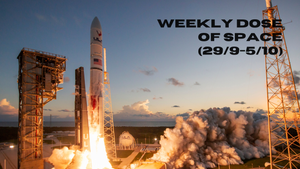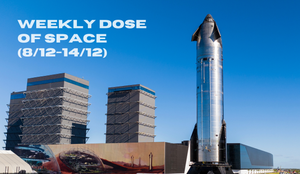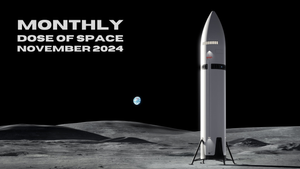
Weekly Dose of Space (29/9-5/10)
Welcome back to Weekly Dose of Space! This week had only one orbital launch occur. News this week had a pioneer of human spaceflight posthumously receive an award, Blue Origin unveiling another booster, and Voyager 2 shutting down an instrument. As always, we'll also look ahead to what the worldwide launch schedule might look like next week.
SpaceX
This week at Starbase began on September 30th when the Ship Quick Disconnect Arm was seen retracting from the Ship 30, a little later the arm was spotted being swung off to the side to move out of the way of a Ship destack.
Shortly after this, Ship 30 was destacked from Booster 12 with the launch towers 'chopsticks'. Ship 30 was then moved out of the way of the chopsticks atop of its transport stand. The hot-staging ring was also removed from Booster 12 while the sun set on Starbase. It is unknown what SpaceX is planning to do with both vehicles ahead of the next flight.
October 3rd had Booster 14 rollout from the production site to the Massey's test site during the early hours of the morning. The following day had water bags arrive at the launch site ahead of testing of the launch towers 'chopsticks', using a specially made piece of hardware these bags were attached to the 'chopsticks' a little later.
The water bags were filled with water on the evening of October 4th to conduct loading tests on the 'chopsticks'. Previous tests like this have been done in the past, recent months have seen the launch towers 'chopsticks' receive minor modifications.
SpaceX tests the chopsticks with load test bags in preparation for a Flight 5 catch attempt, Booster 14 rolls to Massey's for testing, and work continues all over Starbase pushing the Starship Mars rocket program ahead.
— Chris Bergin - NSF (@NASASpaceflight) October 5, 2024
➡️https://t.co/rbL48JkAuq pic.twitter.com/TCWqRD5DRW
The launch towers 'chopsticks' during load testing with the water bags, via NASASpaceflight on X.
Launches This Week
October 4th - Vulcan for Cert-2
The sole launch this week was the second flight of United Launch Alliance's Vulcan rocket. This mission lifted off from Space Launch Complex 41, in Florida, carrying an inert payload and some experiments.
Vulcan's second flight was a success according to the company. An anomaly was observed during the launch as one of the two GEM-63XL solid rocket boosters was seen liberating its nozzle. The first-stage and Centaur V second-stage compensated for the loss of performance to enter the targeting orbit as planned.
Further details about this launch are available here.

In Other Space News
Wang Yongzhi posthumously awarded

Wang Yongzhi (王永志), one of China's space pioneers, was posthumously awarded the Medal of the Republic on September 27th. The Medal of the Republic is the highest honorary medal awarded in the People's Republic of China. Awardees are chosen by the Standing Committee of the National People's Congress, and the medal is presented to the recipients by the President of China.
Wang Yongzhi was born on November 17th 1932 in Liaoning province and attended the prestigious Tsinghua University starting in 1952. In 1955 he traveled to the Moscow Aviation Institute for further studies into aeronautics.
Beginning in 1961, Wang began working at what is today known as the China Academy of Launch Vehicle Technology where he was pivotal in the development of the Dongfeng-2 and Dongfeng-5 ballistic missiles. By 1978 Wang was appointed as the head of the general design department and later became president of the academy in 1986.
Following a gap in the launch market in 1986 after the Challenger Disaster, Wang proposed the Long March 2E rocket. In 1988 the vehicle won its first launch contract and development work began. Eighteen months later the vehicle was ready for launch and successfully lifted of on July 16th 1990 carrying a mass simulator of the Australian Optus B spacecraft and Pakistan's Badr-1 satellite.
In 1992 Wang Yongzhi was named as the first chief planner of China's human spaceflight efforts, then called Project 921. Wang would work in this position for fifteen years overseeing the first six missions and two human spaceflight missions.
In 2007 Wang retired from China's space efforts in an official capacity. During retirement, Wang still offered insights to teams working on the Tiangong Space Station and the crewed lunar landing effort.
Wang Yongzhi passed away on June 11th 2024. Wang Danyang, his wife, said that in his last few months he "still kept talking about things in space, about lunar landing".
Voyager 2 turns off instrument

NASA shared on October 1st that it had turned off Voyager 2's plasma science instrument to save on the reduced power the spacecraft has. Voyager 2 is currently a little over 19 light hours, or almost 12.8 billion miles, away from Earth.
According to NASA, the Voyager 2 team has avoided shutting down the instrument in orbit to gather as much science beyond our solar system's heliosphere, the region of space dominated by our Sun. The plasma science instrument measured the amount of plasma along with the direction it was flowing.
Both Voyager spacecraft are powered by a radioisotope thermoelectric generator, a nuclear battery that uses the heat of decaying material to generate electricity. These power sources output less heat the longer they are used, and as such generate less power.
With this instrument now turned off, teams are continuing to monitor the spacecraft's health in order to maximize the amount of science obtained in interstellar space.
NS-27 to fly new capsule and booster

Blue Origin announced on October 4th that the NS-27 mission with New Shepard would be flying a brand new booster and capsule. NS-27 will also be flying uncrewed to verify both vehicles for human-carrying flights.
The new crew capsule has been named RSS Kármán Line and features undisclosed technology upgrades. New Shepard's new booster also features accommodations to allow for payloads to fly on the booster. A brand new black and white livery is also present, but only the booster was shown off.
Blue Origin's NS-27 mission will fly twelve payloads, seven in the capsule and five on the booster. Payloads onboard include new navigation systems developed for New Shepard and New Glenn; two different LIDAR sensors for the Lunar Permanence program; ultra-wideband proximity operations sensors flying as part of a NASA TechFlights grant with Blue Origin’s Space Systems Development group; and a commercial payload that is a reproduction of black monoliths from 2001: A Space Odyssey. These monoliths are flying on behalf of Spacemanic for a special edition printed by Croatian publisher Amaranthine Books, according to Blue Origin.
What to Expect Next Week
Starbase
No more official information regarding the next flight has been released, so as we have been reporting for the last few weeks, the fifth test flight of SpaceX's Starship-Super Heavy vehicle is still awaiting regulatory approval from the U.S. Federal Aviation Administration. This latest flight test requires a change in the flight plan, notably a potential landing of Booster 12 back at the launch site on the launch towers 'chopsticks'. The Federal Aviation Administration is currently not expected to approve this launch until November due to environmental concerns and SpaceX's late submission of information.
Both vehicles for flight five, Booster 12 and Ship 30, are ready for flight pending a possible wet dress rehearsal.
October 7th - Falcon 9 with Hera
SpaceX is expected to launch the European Space Agency's Hera asteroid exploration mission from Space Launch Complex 40. Hera plans to inspect the asteroid system Didymos that NASA's DART mission impacted in 2022.
October 7th - New Shepard for NS-27
New Shepard is expected to fly the uncrewed NS-27 mission from Blue Origin's West Texas suborbital launch site. Twelve experiments will be onboard the vehicle.
October 9th - Falcon 9 with OneWeb 20
Falcon 9 is believed to be targeting a launch from Space Launch Complex 4E with twenty satellites for OneWeb's satellite internet constellation.
October 10th - Falcon Heavy with Europa Clipper
Falcon Heavy is expected to fly a fully expendable mission carrying NASA's Europa Clipper mission from Launch Complex 39A. Europa Clipper will head to Jupiter's moon Europa to study it.




